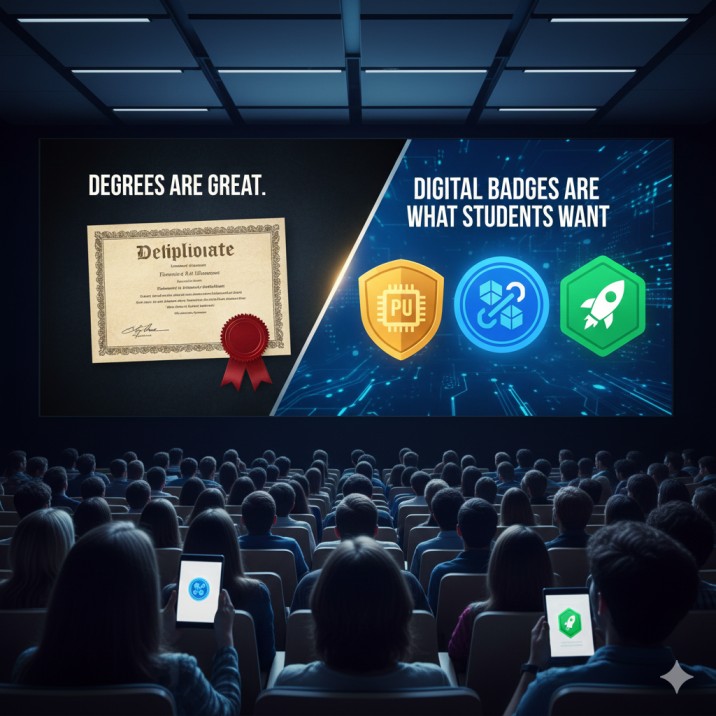The Faculty Shortcut: How Educators Upskill in Half the Time
The Hidden Bottleneck in Faculty Upskilling
Most faculty-development programmes demand months or even years. Yet, the real time sink is beyond content absorption. It includes application, integration, peer feedback, and iteration. Too often, faculty finish a course and then falter when deploying it in their classrooms because support and scaffolding are missing.
A revealing case study published in the Australasian Journal of Educational Technology explored a training course for educators around generative AI. The authors reported that over multiple iterations, participants’ submissions informed ongoing refinements in course content, and weekly discussion boards and assignments were adjusted in real time to optimise learning outcomes. This “live tuning” of faculty upskilling contrasts with static, one-and-done professional development.
Supposedly, a university delivered a 12-week AI fundamentals course to faculty, with coach-led labs and check-ins. After Week 4, coach observations revealed that many struggled with prompt engineering. The remainder of the syllabus was adapted mid-stream to emphasise that, which led to a doubling of lab success rates in Weeks 6–12.
This way, educator training must adapt dynamically, not be rigid.
Micro Modules + Performance-Based Milestones
A “shortcut” is achieved when full-length courses are broken into micro modules (15–45 minutes), coupled with performance-based milestones (small tasks, reflections, peer reviews). These bite-sized units maintain momentum and ensure continuous success without overwhelm.
In the AJET study, course structure included weekly discussion boards visible to all participants and theme-related reflection prompts. That structure mimics micro-module design with built-in peer scaffolding.
For instance, a person enrolled in a 6-module “AI in Education” training. Each module ends in a micro-task (e.g., “draft 3 AI prompts for your next lecture”). Instead of waiting for the final exam, the person iterates per module feedback, finishing with a polished, working prompt bank.
Educators get confidence early, reducing attrition and maximising retention of critical skills.
AI CERTs offers micro-modular tracks for educators with just-in-time feedback loops. Training institutions can become authorised partners to deliver these tracks locally with global quality assurance.
“Just Enough Theory” + Heavy Practice
Contrary to full-theory regimes, a shortcut curriculum layers just enough conceptual grounding to support practice. The rest is hands-on, scaffolded work. In the aforementioned AJET paper, the course repeatedly folded reflections and practitioner activities into theory sessions, not relegating applications to “homework only”.
Instead of beginning with 30 pages of AI theory, an upskilling program offers a 10-minute reading on attention mechanisms, then immediately issues a lab: “Explore how GPT-style attention helps summarisation.” The concept is reinforced through doing, not postponed.
You lock in theory via doing; faculty no longer revisit dry slides later.
Peer Co-Learning Pods + Accountability Groupings
Adult learning research consistently shows that small peer groups accelerate mastery. In the AJET case, weekly discussion boards and shared threaded reflections allowed participants to see each other’s thinking and improve collectively. (AJET)
Think of a cohort of 20 faculty broken into 4 pods of 5. Each pod meets weekly for 30 minutes to discuss prompt strategies, share successes, and troubleshoot together. One pod member suggested a template approach to generating multiple-choice AI prompts; others adopted and improved it.
What’s the advantage? Peer scaffolding prevents “stuckness”, fosters cross-pollination, and speeds iteration.
Embedded Reflection & Iteration Loops
Upskilling must not end at “end-of-course”. A true shortcut system embeds loops: after 1 month and 3 months, faculty revisit tasks, reflect, and iterate. The AJET authors note that participants reflected on GenAI applications in their own teaching practice mid-course and informed modifications dynamically.
After finishing the core training, faculty are asked: “How did your first AI-augmented assignment go? What prompt changes would you make now?” They re-run tests, refine, and produce second versions. This iteration deepens mastery more effectively than front-loaded repetition.
What would have taken 6 months with static content is compressed into an agile 3-month cycle of teach-trial-revise.
Outcome-Centric Track (Publish, Teach, Launch) vs. Completion-Centric
Traditional PD tracks reward “finishing a course”. The faster route rewards outcomes: publish a paper, launch an AI elective, or deliver a prototype assignment.
In the AJET design, participants submitted assignments that were directly applicable to their practice, not just “homework”.
Faculty in a “Generative AI for Education” track must deliver a mini-course module or publish a reflection piece within 8 weeks. Those who succeed get a micro-credential, not just a certificate. That shifts the focus from seat time to real impact.
Why is this faster? Learning is anchored not in hours, but in visible creation. You compress work because you target impact directly.
Bringing the Pieces Together
When combined, these shortcuts form a cohesive architecture:
Micro modules and just-enough theory enable fast absorption
Co-learning pods reduce isolation and accelerate iteration
Embedded loops and reflection prevent learning decay
Outcome-centric focus pushes toward real, usable outputs
Dynamic content refinement (as in the AJET GenAI case) ensures alignment with what faculty actually struggle with
In effect, educators upskill not in “half the time” by skipping content, but by expediting feedback, integrating practice, and focusing on tangible deliverables.
If your university or training institution aims to elevate faculty rapidly into AI-fluent educators, partnering with AI CERTs is your leanest path. Become an Authorised Training Partner (ATP) or Authorised Academic Partner (AAP). We provide:
Micro modular curriculum
Pod facilitation playbooks
Reflection and iteration scaffolding
Global certification alignment
Outcome-based evaluation and recognition
Let us co-design a fast lane for your faculty to become confident AI educators, launch AI electives, embed AI-based pedagogy, and lead in tomorrow’s curriculum today.
Reach out now to become a partner and embed the Faculty Shortcut in your institution.
Recent Blogs

FEATURED
What You Need to Know Before You Become a Partner in EdTech
November 27, 2025
FEATURED
The Benefits of Choosing to Become a Partner in a Global AI Brand
November 27, 2025
FEATURED
Degrees Are Great. Digital Badges Are What Students Want
November 27, 2025
FEATURED
How to Become a Partner and Build a Recurring Revenue Stream
November 27, 2025
FEATURED
Why Becoming a Partner Is the Fastest Way to Enter the AI Education Market
November 27, 2025

